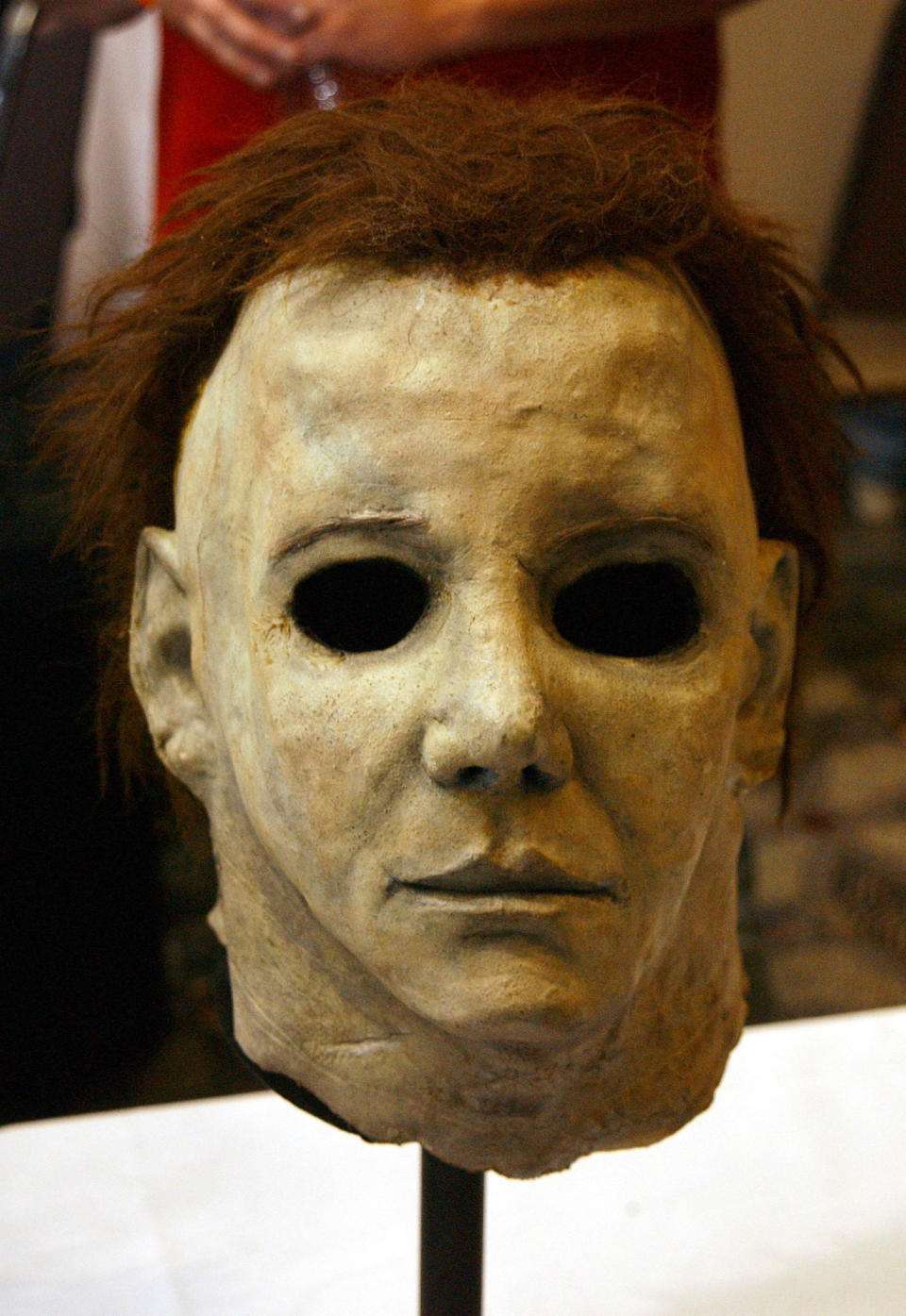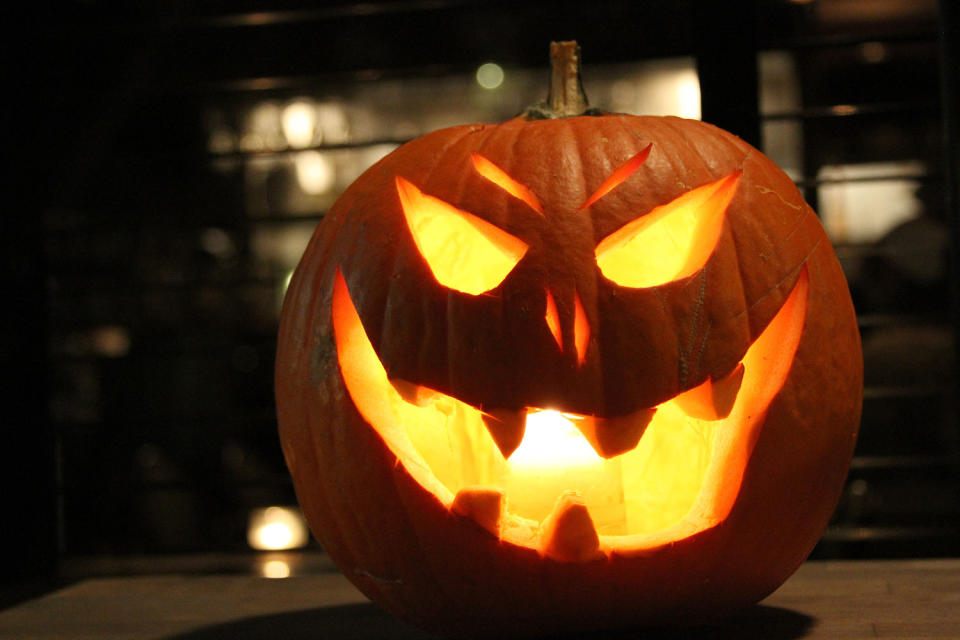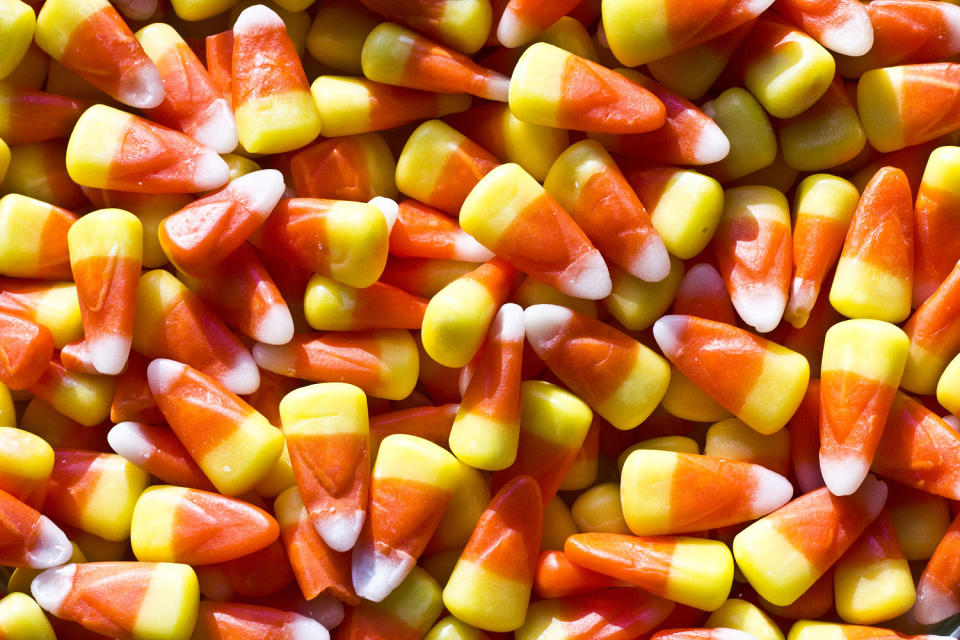Celebrate the spooky season with these spirited Halloween facts
- Oops!Something went wrong.Please try again later.
Is Halloween your favorite holiday? If so, then let's find out how much you know about all things related to October 31, starting with Samhain.
What does the ancient Celtic festival have to do with Halloween? That's easy. For many people, it's believed to be the origin of the year's most fang-tastic holiday.
Let's raise the stakes, shall we?
Do you know how to pronounce Samhain? You might think you do, but chances are, you’ve got it wrong. The correct way to say the word is "SAH-win" not "Sam-hane."
Interested in learning more Halloween facts? Well, you're in luck. We've got a collection of trivia so good, it's positively scary.
Use these fascinating tidbits to test your knowledge or quiz friends and family to see just how much they know about the holiday. Take Belsnickeling, for instance. Any idea what it might have to do with trick-or-treating?
You'll need to scroll on for the answer and, along the way, you'll discover a variety of other Halloween facts sure to give you and your skeleton crew a run for your money.
Whether you're a Halloween movie junkie, love costume statistics or lean more into historical facts and geography, we've got a little something for just about every kind of Halloween enthusiast.
In fact, we bet you don't know if pumpkins are a fruit or vegetable. If you do, you may not know how much the average person spends on Halloween each year, or what the most popular costumes for kids and adults are.
Either way, you're about to find out. So, hit play on your spooky songs playlist to set the mood and let's begin.
The largest Halloween parade in the U.S. takes place in ...
New York City. The annual event, which began in 1973, is held in Greenwich Village. The parade draws nearly 2 million spectators and includes roughly 70,000 costumed participants.
A lot of Americans pretend not to be home on Halloween
A surprising number of Americans don't want to answer the door when trick-or-treaters ring the bell or hand out candy, for that matter. In fact, according to a 2021 YouGov poll, one in five adults (or 21% of respondents) pretend they aren't at home on Halloween night.
Jason Voorhees lives at the bottom of a lake
Jason Voorhees, the sociopath from the "Friday the 13th" movie franchise, is immortalized at the bottom of a Minnesota lake. According to a YouTube video, a diver chained a statue of the fictitious serial killer (hockey mask and all) to the bottom of a mine pit in the city of Crosby, where it remains today.
These U.S. destinations have spooky names
These cities and towns have names befitting Halloween. According to the U.S. Census, they are:
Scarville City, Iowa
Slaughter Beach, Delaware
Tombstone, Arizona
Bad Axe, Michigan
Kill Devil Hills, North Carolina
Sleepy Hollow, New York
Munster, Indiana
'The Conjuring' is based on true life events
The scary movie about a family that moves into a Burrillville, Rhode Island house inhabited by supernatural spirits is based on the real-life case files of paranormal investigators, Ed and Lorraine Warren. Lorraine Warren makes a cameo in the 2013 film, which stars Patrick Wilson, Vera Farmiga and Joey King.
You're probably saying 'Samhain' wrong
Most people consider the ancient Celtic festival of Samhain, a pagan celebration of the fall harvest, to be the origin of modern-day Halloween. However, a majority of them are pronouncing the word "Samhain" incorrectly, saying "Sam-hane." In fact, the word is correctly pronounced "SAH-win."
'Belsnickeling' might have preceded trick-or-treating
Imagine if instead of saying "trick-or-treat," kids rang the doorbell and shouted, "Belsnickel!"
According to the Library of Congress, the old German-American tradition of belsnickeling, a custom in which children dress up in costumes for Christmas and visit their neighbors, is one possible origin of modern-day trick-or-treating. As the tradition goes, during Christmas, kids would visit their neighbors in disguise and have them guess who lurked behind the masks. If they were wrong, they had to pony up treats. Sound familiar?
Pumpkins: Fruit or vegetable?
You ever hear the catchphrase, "A pumpkin a day keeps the doctor away"? Probably not. After all, apples are fruits and pumpkins, well, they're ... also fruits. Yep, you read that right. While Halloween's beloved orange gourds might look like vegetables, they start as flowers and have seeds, which classifies them as a fruit. So, a pumpkin a day might not be such a bad idea after all.
New Hampshire holds the world record for lit jack-o'-lanterns
Sorry, but all your mad pumpkin-carving skills will never match that of Keene, New Hampshire, which holds the record for most lit jack-o-lanterns on display. During the city's annual Pumpkin Fest held on Oct. 19, 2013, a dazzling 30,581 jack-o'-lanterns were lit, breaking the world record.
One U.S. city celebrates 'Beggars' Night'
While most cities and towns celebrate Halloween on its actual date, Oct. 31, residents of Des Moines, Iowa have another tradition called "Beggars' Night." According to the Des Moines Register, the concept began back in the late 1930s after Halloween shenanigans often resulted in a wave of vandalism.
To encourage more positive Halloween activities, "Beggars' Night" was implemented on Oct. 30, the night before the holiday. On that night, children went door to door to get "treats for eats," but only if they told a joke first. More than 80 years later, the practice still continues in and around Des Moines making the holiday a days-long affair.
Halloween falls on a full moon every 19 years
Based on movies and popular Halloween images, it's tempting to think that the year's spookiest holiday always lands on a full moon. How else would werewolves make an appearance? More important, a full moon is the best way to see a witch (and her trusty black cat) flying through the night. However, according to a NASA news article, full moons on Halloween are exceptionally rare, occurring only once every nineteen years or so, making them, indeed, once in a blue moon.
Magician Harry Houdini died on Halloween
Known for his wondrous illusions, Harry Houdini defied all reason in 1908 when he somehow escaped from a water-filled milk can in which he was shackled and chained. To this day, the stunt remains one of the most well-known tricks and immortalized the magician. It seems fitting, then, that the escape artist ultimately exited this world on the most supernatural days of the year. On Oct. 31, 1926, Houdini died, not of a stunt gone wrong, but of a burst appendix.
The White House was first decorated for Halloween in 1958
Mamie Eisenhower decorated the White House for a Halloween for the first time. She decked out the State Dining Room in twinkle lights, shocks of dried corn, jack-o'-lanterns and autumnal flower arrangements for a lunch for wives of staff members. Things took a spooky turn outside the dining room, though: Black cats, owls, witch heads and goblins hung from chandeliers in the foyer.
Americans spend more than $100 on Halloween
And it's not going down anytime soon. In 2023, the National Retail Federation estimates that Americans will spend an average of $108 on costumes, candy, decorations and greeting cards.
Jack Nicholson's divorce inspired a scene in "The Shining"
There's a scene in "The Shining" that writers — including Nicholson — know all too well: Wendy approaches Jack at his typewriter and he scolds her for trying to get in the way of his writing process. Nicholson later revealed that his character's reaction, although exaggerated, stems from his own personal experience.
"That scene at the typewriter — that’s what I was like when I got my divorce. I was under the pressure of being a family man with a daughter and one day I accepted a job to act in a movie in the daytime and I was writing a movie at night and I’m back in my little corner and my beloved wife, Sandra, walked in on what was, unbeknownst to her, this maniac — and I told Stanley [Kubrick] about it and we wrote it into the scene," the actor told The New York Times.
William Shakespeare wrote the "Song of Witches"
“Double, double toil and trouble; Fire burn and caldron bubble” is from William Shakespeare’s “Macbeth.” A trio of witches recite the poem as they scheme over a bubbling cauldron and it's been associated with witches ever since.
People used to carve turnips, not pumpkins
Initially, the Irish and Scottish carved turnips as a way to remember deceased souls. When they immigrated to the U.S., they realized that pumpkins were much easier to carve and the rest, as they say, is history.
Most popular costumes of 2023
According to Google, these are the top Halloween costumes of 2023:
Barbie
Princess
Spider-Man
Witch
Fairy
Wednesday Addams
Dinosaur
Cowboy
Ninja
Bunny
Halloween was once known as "Black Halloween"
Before costumes and trick-or-treating, Halloween was a night for pranking. The pranks eventually got out of control and in 1933, vandals caused millions of dollars of damage across the U.S., leading many people to refer to it as “Black Halloween.”
Trick-or-treating began in Canada (possibly)
The origins of trick-or-treating are still up for debate. Although some believe trick-or-treating dates back to medieval times, Henry Ansgar Kelly, a research professor specializing in medieval and renaissance studies at UCLA, said it may have started in Canada during the early 1900s as a way to deter pranksters from wreaking havoc.
Michael Myers was inspired by Captain Kirk

Netflix's "The Movies That Made Us" revealed the connection between "Halloween" and "Star Trek." The Michael Myers mask in the movie was actually reconstructed from an old Captain Kirk mask. Tommy Wallace, the film’s production designer, shaved off the eyebrows and sideburns, then dyed the hair brown to give it its signature Michael Myers look.
Halloween isn't Day of the Dead (and vice versa)
While the Day of the Dead (Día de los Muertos) is often associated with Halloween, it shouldn't be. The Mexican holiday dates back more than 3,000 years and is a time to honor deceased loved ones. That said, it shouldn't be associated with costumes, candy and other Halloween traditions.
Halloween generates billions of dollars
Around $12.2 billion, to be exact. The most recent survey from the National Retail Federation predicts that Halloween will generate a record-breaking $12.2 billion in 2023, up from $10.6 billion in 2022.
All Saints Day is not All Souls Day
Celebrated on November 1, All Saints Day honors the death of Catholic saints and loved ones. All Souls Day, on November 2, is observed to pray for souls of the faithfully departed that remain trapped in purgatory in hopes they'll be admitted to heaven.
Halloween may have started in 600 A.D.
Many experts believe that Halloween stems from Samhain, a Gaelic festival to celebrate the end of summer. The first known celebrations of Samhain are said to have occurred around 600 A.D., making Halloween more than 3,500 years old.
Retailers made Halloween popular
From 1909 to the 1940s, the Dennison Manufacturing Co., a paper goods manufacturer located in Framingham, Mass., was one of the leading producers of Halloween costumes, invitations and decorations in the U.S. The rise in available Halloween-related goods spurred the popularity of the holiday.
Trick-or-treating took off in the 1930s
Lisa Morten, author of “Trick of Treat: The History of Halloween,” said the first official mention of trick-or-treating as a Halloween activity in the U.S. was published in the November 1939 issue of "American Home" magazine.
Americans love pet Halloween costumes
According to the National Retail Federation, in 2023, consumers are expected to spend nearly a billion dollars on pet costumes.
The most popular pet Halloween costumes of 2023 are as follows:
Pumpkin
Hot dog
Bat
Bumblebee
Spider
The Headless Horseman isn't linked to Halloween
Though everyone associates Halloween with “The Legend of Sleepy Hollow,” the original Washington Irving short story doesn’t mention Halloween even once. It’s the 1949 Disney movie, “The Headless Horseman,” that makes the connection between the two.
The first guide to Halloween came out in 1897
Before there were magazine articles, TV segments and other helpful how-to's, Americans relied on annual Halloween guides to answer their top questions. The first official Halloween party guide, titled "Halloween: How to Celebrate It," was published in 1897.
Stingy Jack inspired jack-o'-lanterns

"Stingy Jack," a drunk and deplorable person, cheated death three times and, each time, tricked the devil out of taking his soul. When Jack finally died, he wasn’t allowed into heaven and the devil banned him from hell. Instead, Jack was forced to wander Earth for all eternity using an ember-lit gourd to light his way.
There are millions of trick-or-treaters
In 2021, the U.S. Census estimated that there would be upwards of 42 million trick-or-treaters between the ages of five and 14. And the number of potential stops for those trick-or-treaters was a whopping 128 million. That’s a lot of candy.
Europe doesn't celebrate Halloween like the U.S.
Even though Halloween was brought to the U.S. from Irish and Scottish immigrants, the rest of Europe didn’t begin celebrating the holiday until decades later. Although many European countries now celebrate the holiday, it hasn't been quite as commercialized as the U.S.
It wasn't always called "Halloween"
There are several theories about the origin of the word “Halloween.” According to the Oxford English Dictionary, "Halloween" stems from “All Hallow’s Eve.” However, in 1773, the Scottish began calling it, “Hallow-e’-en.”
Then, a few years later, poet Robert Burns put the words together in the poem titled “Halloween” and we’ve been writing it that way ever since.
Halloween postcards used to be a thing
From 1905 to 1920, more than 3,000 Halloween postcards were mass-produced. For years, people popped Halloween greetings in the mail until the telephone became the preferred method of communication.
Everyone loves candy (like a lot)
So many Halloween activities, so little time! In 2022, the National Retail Foundation said that passing out candy was the most popular way to spend Halloween— and understandably so. Other common ways that people celebrate include:
Decorating their home or yard
Dressing up in costume
Carving pumpkins
Throwing or attending a party
People used to carve other fruits
Think beyond the gourd! U.S. magazines and Halloween guides from the late 1800s offered tips on how to carve apples and cucumbers in addition to jack-o’-lanterns.
Candied apples were a total mistake
The beloved Halloween treat is said to have been invented by William W. Kolb, a New Jersey confectioner, in 1908. The candy maker supposedly dipped an apple into a cinnamon glaze as an experiment and discovered that patrons loved them.
Rhode Island is home to 6,000 jack-o'-lanterns
The annual Jack-O-Lantern Spectacular held at the Roger Williams Park Zoo in Providence, Rhode Island displays more than 6,000 jack-o’-lanterns during their annual festival. It's one of the largest displays in the country, drawing roughly 115,000 to 140,000 visitors each year.
Black cats get a bum rap
Black cats are undeservedly associated with bad luck. Their reputation dates way back to the Middle Ages when people considered them a sign of the devil. Hundreds of years later, black cats became the object of fear and scorn after being linked to witches and black magic.
Candy corn has been around since the 1800s

Originally dubbed “Chicken Feed,” candy corn became popular once the Goelitz Company took over production in the late 1800s. Love it or hate it, he sugary-sweet treat become a Halloween staple in the 1950s.
Transylvania is located in the U.S.
If you love vampires and want to visit Transylvania, you need only book a trip to North Carolina. Known as the “Land of Waterfalls,” (not vampires, who knew?), Transylvania County is located in western North Carolina and is home to roughly 34,000 residents. The official Bram Stoker version is in Romania.
Halloween isn't just for kids anymore
Once upon a time, Halloween was all about kids and while that's still true, adult participation is growing year over year. According to the NRF, Roughly 55% of households without children planned to celebrate Halloween in 2021 (up from 49% back in 2020). In 2022, annual spending on adult Halloween costumes was predicted to top 1.7 billion dollars.
The most popular Halloween candy is ...
Are you ready for this one? According to research by YouGov, the most popular Halloween candy is (drum roll, please) M&Ms! Reese's Peanut Butter Cups come in a close second. Interestingly enough, their findings show kids ages 8 to 14 prefer the two in reverse order. Go figure!
Here is the most popular Halloween candy for adults, ranked:
M&Ms (original)
Reese's Peanut Butter Cup
Kit Kat
Peanut M&Ms
Butterfinger
Snickers
Twix
Milky Way
Hershey's Milk Chocolate Bar
Reese's Pieces
This article was originally published on TODAY.com

